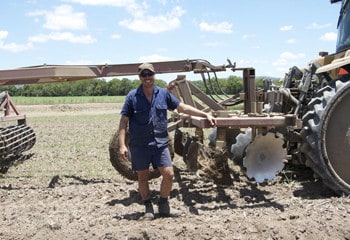Assessment of appropriate nitrogen rates for a paddock with two distinct management zones
John and Phil Deguara farm sugarcane at North Eton. On their farm they have a number of paddocks badly impacted by sodic soils. This results in varied yields within some individual blocks; with high yielding zones of above 85 tonnes per ha and low yielding zones of below 60 tonnes per ha.
Traditional nutrient management practice is to apply the same rate of nitrogen across the entire block. Clearly the low yielding zones will not be able to utilise the nitrogen at the same rate as the high yielding zones, resulting in a nutrient surplus unable to be used by the crop, which leads to a potential water quality risk and a poor economic outcome.
Trial overview
With funding from the Federal Government’s Action on the Ground Carbon Farming Futures program John and Phil have worked with Reef Catchments and agronomists from Farmacist to trial a variable rate nitrogen application program on one of their sodic blocks.
The trial seeks to learn whether applying high or low rates of nitrogen to sodic/low yielding soils will impact yield and conversely whether applying high or low nitrogen rates to high yielding zones will impact on yield.
This is tested through strip trials set out on a block that has been EM Mapped, with soil tests completed for each delineated zone. Replicated strips of high, low and medium nitrogen rates have been set out across the yield zones aswell as strips with variable rate nitrogen application targeting the specific zones.
Table 1: John and Phil Deguara site Treatments and descriptions
Treatments Descriptions
T1 N rate of 90kg/ha
T2 N rate of 160kg/ha
T3 N rate of 230kg/ha
T4 Variable rate – N at rates of 90kg/ha in low yield potential zone and 150 kg/ha in the high yield potential zone
Trial outcomes to date
This trial has run for two years with results indicating the potential to reduce nitrogen rates through a variable rate program where yield potential is impacted through sodic conditions without compromising yield.
Soil test results from locations in the high and low potential yield zones validated that the high sodium levels (ESP) are the primary driver for the low yield potential of the western section of the trial block.
High ESP levels also coincide with lower soil organic carbon levels on the western side of the block. (Figure 2)
Yield results for each treatment in the low yielding zone showed no significant difference in cane productivity across the four nitrogen treatments, indicating that applying higher rates will not improve crop growth in these zones. (Figure 3)
In the high yielding zone the 90 kg N treatment yielded approximately 12 ton/ha of cane lower than the average yields of the other N rate treatments (8 tonne in 2013). (Figure 3) This indicates that on known high yielding zones a higher rate of nitrogen can be used by the crop to produce a higher yield.
o The results indicate the potential to reduce N rates in a variable rate program where yield potential is impacted through sodic conditions.
Maintaining yield with reduced N rates in sodic zones of paddocks significantly improves nitrogen use efficiency (Figure 4).
Selecting a reduced nitrogen rate that will maintain the realistic yield potential of sodic zones within paddocks significantly improves nitrogen use efficiency and has the potential to reduce nitrogen loads in runoff and N20 emissions.
Reef Catchments is supporting further applied research to refine nitrogen rates based on the long term yield potential of soil profile groups with specific physical properties with defined soil chemical restraints i.e. sodic soils.
Table 2: John and Phil Deguara site cane and sugar yield comparisons between nitrogen treatments and yield zone.


